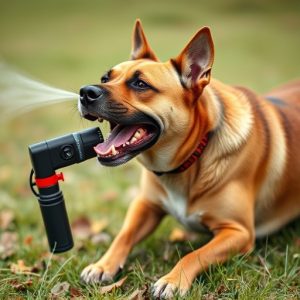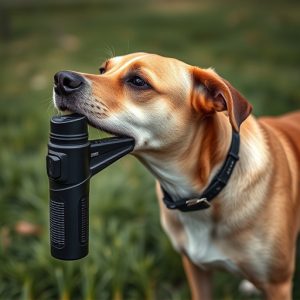Dog Pepper Spray Defense: Ingredients, Mechanisms, Legalities & Choice
The effectiveness of canine pepper spray depends on its oleoresin capsicum (OC) percentage, with hig…….
The effectiveness of canine pepper spray depends on its oleoresin capsicum (OC) percentage, with higher concentrations providing stronger protection by temporarily disorienting and neutralizing attackers. Legal regulations govern OC concentration, with higher levels reserved for law enforcement due to potential misuse. When selecting a spray, consider canine-specific formulations, weather resistance, range, and stream pattern. Training is crucial for safe and effective use, ensuring dogs and handlers understand application techniques and behavior post-deployment. Always follow local laws and safety standards regarding OC percentage and responsible usage.
“Unleashing the power of self-defense for your four-legged companion? Dog pepper spray offers a non-lethal solution, but understanding its mechanics and legalities is crucial. This comprehensive guide explores the active ingredients and OC Percentage in canine pepper spray, revealing how it disrupts an attacker’s senses. We’ll navigate legal considerations, essential factors for selection, and safety protocols for responsible use. By the end, you’ll be equipped to make informed choices for your dog’s protection.”
- Understanding Dog Pepper Spray: Active Ingredients and OC Percentage
- How Dog Pepper Spray Works: Mechanisms of Irritation and Disorientation
- Legal Considerations: Canine Pepper Spray Usage and Regulations
- Choosing the Right Dog Pepper Spray: Factors to Consider for Effective Defense
- Training and Safety Protocols: Responsible Use and Management of Pepper Spray for Dogs
Understanding Dog Pepper Spray: Active Ingredients and OC Percentage
Dog pepper spray is designed to deter and incapacitate an attacker, providing a window of safety for the dog and its owner. Understanding the components that make up this defensive tool is crucial. The active ingredient in canine pepper spray is typically oleoresin capsicum (OC), a natural chemical compound derived from chili peppers. The OC percentage in these sprays varies, but it’s a key factor in determining its effectiveness.
The concentration of OC, measured as a percentage, indicates the strength of the spray. Higher OC percentages mean more potent irritants, leading to faster disorientation and neutralization of the target. This feature is especially important for dog pepper spray, as it needs to quickly disrupt an attacker’s vision, breathing, and balance, allowing the canine companion to escape unharmed.
How Dog Pepper Spray Works: Mechanisms of Irritation and Disorientation
Dog pepper spray, designed for self-defense purposes, operates by leveraging capsaicin, the active ingredient found in chili peppers. When deployed, the spray releases a fine mist containing capsaicin at a specific concentration, typically measured in OC (oleoresin capsicum) percentage. The OC Percentage in canine pepper spray can vary, but it’s crucial to understand that even low concentrations are enough to cause immediate irritation and disorientation.
Upon inhalation or contact with the eyes and skin, capsaicin binds to nerve endings, triggering a sensation of intense pain and burning. This mechanism disrupts an individual’s balance and coordination, making them more vulnerable and providing the user with precious seconds to escape a potential threat. The effect is short-lived, but it’s powerful enough to give dogs and their owners a crucial advantage in deterring and avoiding dangerous encounters.
Legal Considerations: Canine Pepper Spray Usage and Regulations
In many jurisdictions, the use of pepper spray—including canine-specific varieties—is subject to stringent legal regulations. These laws vary widely across regions, with some areas prohibiting its civilian use entirely, while others allow it under specific circumstances. One key consideration is the OC (Oleoresin Capsicum) percentage in the spray. Higher concentrations can cause more severe irritation and are often reserved for law enforcement agencies due to their potential for excessive force.
Canine pepper spray, designed to deter attacking or aggressive dogs, must adhere to safety standards and label guidelines. Regulations typically dictate who can possess, carry, and use such sprays, with restrictions often based on age, training, and certification. Users must also understand “reasonableness” in applying the spray—using more force than necessary could lead to legal repercussions. Awareness of local statutes is crucial for responsible dog pepper spray ownership and application.
Choosing the Right Dog Pepper Spray: Factors to Consider for Effective Defense
When selecting a dog pepper spray, understanding its active ingredient and concentration is paramount. The primary component, oleoresin capsicum (OC), delivers the irritating effect. Dog pepper sprays typically contain OC in varying percentages, ranging from 5% to 10%. Higher concentrations offer more protection but come with increased risk and should be used cautiously, especially around children or other pets.
Other factors influence the choice of the right spray. Canine-specific formulations ensure safety and effectiveness as they are designed to temporarily disable without causing severe harm. Weather resistance is another critical aspect, as sprays that withstand rain or humidity guarantee their potency during outdoor incidents. Additionally, consider the spray’s range and stream pattern for optimal coverage and control during an attack.
Training and Safety Protocols: Responsible Use and Management of Pepper Spray for Dogs
Training and safety protocols are paramount when considering dog pepper spray defense. It’s crucial to understand that any use of force, including pepper spray, should be a last resort and used responsibly. Canine pepper spray typically contains an OC (oleoresin capsicum) percentage ranging from 10% to 20%, designed to temporarily disable or deter aggressive dogs without causing severe harm.
Training for both the dog and the handler is essential. Dogs must be conditioned to respond appropriately to the spray, learning to avoid triggering situations. Handlers should receive comprehensive instruction on safe application techniques, understanding their dog’s behavior during and after deployment. Regular mock scenarios can help prepare both dog and handler for real-life encounters, ensuring a calm and controlled response when needed.
Dog pepper spray can be an effective tool for self-defense when used responsibly and according to legal guidelines. Understanding the active ingredients, such as OC (oleoresin capsicum) with a specific percentage, is key to its effectiveness. Knowing how it works, both in terms of irritation and disorientation, ensures safe and strategic deployment. Legal considerations vary, so owners must stay informed about regulations in their area. Choosing the right spray involves considering factors like range, power, and application method. Ultimately, proper training and safety protocols are essential for responsible use, ensuring the well-being of both pets and those around them.


